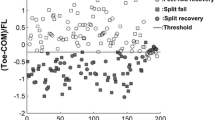Abstract
Slip is one of the leading causes of accidental falls. Load-carrying and fatigue might increase risk of slip-induced falls during locomotion. The objective of this study was to determine the main and interactive effects of load carriage and fatigue on gait characteristics at heel contact. An experiment was carried out with five participants walking on a medical treadmill. Different back-carrying loads were applied before and right after the fatiguing exercise. The heel velocity and heel deceleration right before heel contact and the heel contact angles were examined. The results showed that the both heel contact velocity and deceleration increased with fatigue and with the application of the heavy load. These findings suggest that both fatigue and back-carrying load increase the risk of slip-induced falls by compromising gait stability at heel contact. Findings from this study can aid in developing interventions that are able to minimize fall risks especially with the application of fatigue and/or external load.
Access this chapter
Tax calculation will be finalised at checkout
Purchases are for personal use only
Similar content being viewed by others
References
US Bureau of Labor Statistics. National Census of Fatal Occupational Injuries in 2004. http://www.bls.gov/news.release/archives/cfoi_08252005.pdf
Rubenstein, L.: Falls in older people: epidemiology, risk factors and strategies for prevention. Age Ageing 35(1), 37–41 (2006)
Liberty Mutual Research Institute for Safety: 2012 Liberty Mutual Workplace Safety Index. http://www.libertymutual.com/researchinstitute
Prince, F., Corriveau, H., Hebert, R., Winter, D.A.: Gait in the elderly. Gait Posture 5(2), 128–135 (1997)
Hanson, J., Redfern, M., Mazumdar, M.: Predicting slips and falls considering required and available friction. Ergonomics 42(12), 1619–1633 (1999)
Redfern, M., Cham, R., Gielo-Perczak, K., Gronqvist, R., Hirvonen, M., Lanshammar, H., Powers, C.: Biomechanics of slips. Ergonomics 44(13), 1138–1166 (2001)
Chang, W.R., Chang, C.C., Matz, S.: Comparison of different methods to extract the required coefficient of friction for level walking. Ergonomics 55(3), 308–315 (2012)
Courtney, T., Sorock, G., Manning, D., Collins, J., Holbein-Jenny, M.: Occupational slip, trip, and fall-related injuries-can the contribution of slipperiness be isolated? Ergonomics 44(13), 1118–1137 (2001)
Bentley, T.: Slip, trip and fall accidents occurring during the delivery of mail. Ergonomics 41(12), 1859–1872 (1998)
Bentley, T., Tappin, D., Moore, D., Legg, S., Ashby, L., Parker, R.: Investigating slips, trips and falls in the new zealand dairy farming sector. Ergonomics 48(8), 1008–1019 (2005)
Chang, W.R., Li, K.W., Filiaggi, A., Huang, Y.H., Courtney, T.: Friction variation in common working areas of fast-food restaurants in the USA. Ergonomics 51(12), 1998–2012 (2008)
Haslam, R., Hide, S., Gibb, A., Gyi, D., Pavitt, T., Atkinson, S., Duff, A.: Contributing factors in construction accidents. Appl. Ergon. 36(4), 401–415 (2005)
Hsiao, H., Simeonov, P.: Preventing falls from roofs: a critical review. Ergonomics 44(5), 537–561 (2001)
Redfern, M., Bidanda, B.: Slip resistance of the shoe floor interface under biomechanically-relevant conditions. Ergonomics 37(3), 511–524 (1994)
Attwells, R.L., Birrell, S.A., Hooper, R.H., Mansfield, N.J.: Influence of carrying heavy loads on soldiers’ posture, movements and gait. Ergonomics 49, 1527–1537 (2006)
Birrell, S.A., Haslam, R.A.: The effect of military load carriage on 3-D lower limb kinematics and spatiotemporal parameters. Ergonomics 52, 1298–1304 (2009)
Liu, J., Lockhart, T.E.: Local dynamic stability associated with load carrying. Saf. Health Work 4(1), 46–51 (2013)
Lew, F.L., Qu, X.: Effects of mental fatigue on biomechanics of slips. Ergonomics 57(12), 1927–1932 (2014)
Qu, X.: Effects of lower-limb muscular fatigue on stair gait. J. Biomech. 48(15), 4059–4064 (2015)
Qu, X., Yeo, J.C.: Effects of load carriage and fatigue on gait characteristics. J. Biomech. 44, 1259e1263 (2011)
Kong, P.W., Beauchamp, G., Suyama, J., Hostler, D.: Effect of fatigue and hypohydration on gait characteristics during treadmill exercise in the heat while wearing firefighter thermal protective clothing. Gait posture 31(2), 284–288 (2010)
Hu, X., Qu, X.: Differentiating slip-induced falls from normal walking and successful recovery after slips using kinematic measures. Ergonomics 56(5), 856–867 (2013)
Borg, G.A.: Psychophysical bases of perceived exertion. Med. Sci. Sports Exerc. 14, 377–381 (1982)
Zeni, J.A., Richards, J.G., Higginson, J.S.: Two simple methods for determining gait events during treadmill and overground walking using kinematic data. Gait posture 27(4), 710–714 (2008)
Lockhart, T., Kim, S.: Relationship between hamstring activation rate and heel contact velocity: factors influencing age-related slip-induced falls. Gait Posture 24(1), 23–34 (2006)
Lockhart, T., Woldstad, J., Smith, J.: Effects of age-related gait changes on the biomechanics of slips and falls. Ergonomics 46(12), 1136–1160 (2003)
Beschorner, K., Cham, R.: Impact of joint torques on heel acceleration at heel contact, a contributor to slips and falls. Ergonomics 51(12), 1799–1813 (2008)
Author information
Authors and Affiliations
Corresponding author
Editor information
Editors and Affiliations
Rights and permissions
Copyright information
© 2016 Springer International Publishing Switzerland
About this paper
Cite this paper
Hu, X., Qu, X. (2016). The Effect of Back-Carrying Load and Fatigue on Gait Characteristics at Heel Contact. In: Goonetilleke, R., Karwowski, W. (eds) Advances in Physical Ergonomics and Human Factors. Advances in Intelligent Systems and Computing, vol 489. Springer, Cham. https://doi.org/10.1007/978-3-319-41694-6_52
Download citation
DOI: https://doi.org/10.1007/978-3-319-41694-6_52
Published:
Publisher Name: Springer, Cham
Print ISBN: 978-3-319-41693-9
Online ISBN: 978-3-319-41694-6
eBook Packages: EngineeringEngineering (R0)




